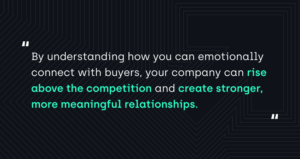No matter what purpose your product or solution serves, something about it creates a genuine feeling of happiness for the people that use it ー and right now, people are craving authentic, uplifting moments more than ever. That’s why it’s important to identify how your product creates true joy for your customers and communicate that attribute as part of the value your brand provides.
With an understanding of how you are emotionally connecting with customers, your company can rise above the noise, go beyond the competition, and create stronger, more meaningful relationships.
It begins with adopting mindset that your mission for customers is joy.
It can be challenging to identify where customers experience joy when they interact with your company. Here are 7 things our B2B Marketing agency recommends you do to uncover how you are already creating moments of happiness for customers, or where you can start infusing it.

1. Take a Long, Outsider’s Look at your Product or Service
Chances are, you are already doing something that creates joy and you are not even aware of it. The best way to find it is to watch real customers using your product. You will most likely find a common reaction that manifests in one of these ways:
Surprise — a joyful experience always exceeds our expectations, creating delight, amazement, wonder or awe.
Anticipation — anticipating joy is almost as good as the experience itself. Think of the feeling you get when a movie is about to start, and the theater lights dim.
Resonance — joy touches the emotions and resonates at a deep level, causing physical reactions like goose bumps, laughter or even tears.
Clarity —an experience filled with joy allows people to see things in a new light or find solutions that ease life’s complexities.
Once you find your emotional element or joy factor, you will probably need to increase or build on it. Also make sure you ask two important questions:
- What can I be doing to leverage my product or service to extend the customer’s joy?
- How can I capture the moment of authentic joy experienced by my customers and harness it to invoke a feeling of anticipation in my prospects?
2. Set the Stage for the Experience
First impressions matter when building a brand, so make sure you introduce the experience of working with you as something premium. You have an opportunity to spark joy right from the start of the customer experience by paying special attention to what happens when they receive your product or are first introduced to your service offering.
If you are shipping product to the customer:
- What can you do to excite the customer to get started and to let them know their purchase is appreciated?
- Is it packaged well or in an interesting way?
- How is the packaged product typically shipped and how is that experience?
If you are providing a service:
- How is the customer initiated into your service? Can you find a way to build anticipation before you start?
- What does the first day consist of and can you find a way to overwhelm or surprise them with value?
Consider the entire experience and make it your goal that you overwhelm them with such a premium interaction that they share it with their peers.
3. Deliver Holistic Value
Your customers come to you for value. To deliver holistic value beyond what they might expect, give them value high (the best product/service you can possibly provide) and give them value wide (where you anticipate how a product/service might be used, identify creative opportunities, and offer suggestions to drive additional value beyond what was originally anticipated). Holistic value drives joy that is contagious and long lasting. Tip #5 is an example of how we worked value wide into this article!
4. Save Them a Step
There’s a reason why soup cans have pull-tabs and sour cream comes in squeeze packets. Look for little ways to make life easier for the customer in everything you deliver. What will they be doing with your product/service after you deliver it to them? Will they need to share it internally? What could you do that would eliminate that extra work for them? When you save customers a step you make it easier to work with you and give them something everyone finds joy in – extra time.
5. Move the Relationship Forward
Whether yours is a service-oriented or product-centric company, your customers probably have a mindset about working with you that fits into one of three categories. If you recognize how your customer perceives your relationship, there are specific tactics you can use that will effectively elicit joy for them. These categories were developed by AMI as part of a hiring and firing insights report for agencies but we find they hold true for most B2B buyers. Here are the three categories, and tactics that can evoke joy for each:
“Been Burned” Customers – buyers who have had a poor experience with another vendor. They have low levels of trust and evaluate your performance with them from day one.
Tactic: The top reasons that customers leave vendors are that the solution didn’t work and/or there wasn’t enough attention paid to the customer. Overwhelm them with service and make sure you understand their criteria for success. They will find real joy in knowing that this time, they made a good choice.
“Arm’s Length” Customers – buyers who are required to review multiple vendors frequently (even if they’ve already identified the one they want to hire or they’re happy with the one they’ve got). They’re less emotionally engaged in the hiring process, do less research on prospective companies, and rely more on characteristics like vendor visibility and prestige, awards, media coverage and offices.
Tactic: Give them reasons to think of you as very unique because you understand their industry and their company. Provide unexpected value by giving them additional, well-thought perspective related to these things and it will provide them a joyful surprise.
“Kindred Spirit” Customers – buyers who look for a personal connection with their vendors. They expect you to know their company and industry well. They hire for expertise, plan to follow their vendor’s recommendations, and expect to see data that reflects specific results achieved for clients.
Tactic: This may be the most difficult segment to joyfully surprise because they already expect a lot of you. Make sure you deliver on that expectation by bringing more value than what might be seen as standard in your industry. Specifically, give them tons of high-level strategic ideas as well as strong tactical ones that align with their organizational goals and what you do for them. Consider surprise gifts as part of your process of deepening your customer retention plan. Remember that they see you as a trusted friend – respect that and treat them the same way. Working with you will be so enjoyable that they will never leave.
6. Socialize
Everyone feels happy when they are liked on social media. Tap into that emotion by following your customers on social media and making an effort to share their corporate social posts and PPC ads. See a quote, article or statistic praising one of your customers or their products and services? Help to extend that joy by putting it in your newsletter or posting it on your social channels. Show them that you are a kindred spirit and their success matters to you.
7. Don’t Forget to Mug ‘Em
Make a consistent practice to send your customers a small gift out of the blue with no sales pitch attached. These days in the B2B world, thank you gifts like food, quality clothing, and coffee mugs are never expected but most often appreciated. Pro tip: send customized, client-branded items rather than using your company logo.
These are just a few ways to find joy in your products/services and instill it in your customer experience. Once you tap into those emotional connections and discover how to replicate them, the results will bring you true joy.

